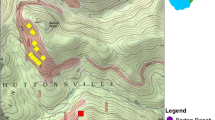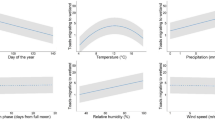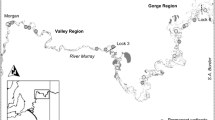Abstract
The distribution and function of small, temporarily ponded wetlands such as vernal pools are driven by climate variation, especially precipitation. These wetland ecosystems provide important habitat for amphibians, whose breeding effort (egg deposition) is often used to characterize pool habitat quality. However, whether breeding effort consistently predicts larval survival, juvenile production, and overall reproductive output—key indicators of habitat quality for amphibians in a varying environment—remains unclear. We assessed the occurrence of spotted salamander (Ambystoma maculatum) and wood frog (Lithobates sylvaticus) larvae in 71 vernal pools in New York, USA during the spring and summer of 2016 and 2017—the fifth driest and third wettest years in regional history, respectively—to better understand the relationship between breeding effort and metamorph production under environmental extremes. Breeding effort was an important predictor of whether late-stage larvae occurred in pools for both species. However, occurrence of late-stage larvae was substantially lower for both species during 2016, i.e., the drought year, when pools dried rapidly. These outcomes suggest that, in the face of an increasingly variable climate, prioritizing clusters of pools that encompass a range of hydroperiods and include high-productivity pools would help maintain populations of vernal-pool dependent amphibians.




Similar content being viewed by others
Data Availability
Please contact corresponding author.
References
Altig R, McDiarmid RW (2015) Handbook of larval amphibians of the United States and Canada. Cornell University Press, Ithaca
Berven KA (1990) Factors affecting population fluctuations in larval and adult stages of the wood frog (Rana sylvatica). Ecology 71:1599–1608
Brooks RT (2004) Weather-related effects on woodland vernal pool hydrology and hydroperiod. Wetlands 24:104–114
Brunner JL, Barnett KE, Gosier CJ et al (2011) Ranavirus infection in die-offs of vernal pool amphibians in New York, USA. Herpetological Review 42:76–79
Burnham KP, Anderson DR (2002) Model selection and inference: A practical information-theoretic approach. Springer-Verlag, New York
Cade BS (2015) Model averaging and muddled multimodal inferences. Ecology 96:2370–2382
Calhoun AJK, Walls TE, Stockwell SS, McCollough M (2003) Evaluating vernal pools as a basis for conservation strategies: a Maine case study. Wetlands 23:70–81
Calhoun AJK, Arrigoni J, Brooks RP et al (2014) Creating successful vernal pools: a literature review and advice for practitioners. Wetlands 34:1027–1038
Calhoun AJK, Mushet DM, Bell KP et al (2017) Temporary wetlands: challenges and solutions to conserving a ‘disappearing’ ecosystem. Biological Conservation 211:3–11
Colburn EA (2004) Vernal pools: Natural history and conservation. McDonald & Woodward, Blacksburg
Crouch WB, Paton PWC (2000) Using egg-mass counts to monitor wood frog populations. Wildlife Society Bulletin 28:895–901
Curtis AE, Paton PWC (2010) Assessing detection probabilities of larval amphibians and macroinvertebrates in isolated ponds. Wetlands 30:901–914
deMaynadier PG, Hunter ML (1995) The relationship between forest management and amphibian ecology: a review of the North American literature. Environmental Review 3:230–261
DiMauro D, Hunter ML (2002) Reproduction of amphibians in natural and anthropogenic temporary pools in managed forests. Forest Science 48:397–406
D’Orangeville L, Maxwell J, Kneeshaw D et al (2018) Drought timing and local climate determine the sensitivity of eastern temperate forests to drought. Global Change Biology 2018:1–13
Egan RS, Paton PWC (2004) Within-pond parameters affecting oviposition by wood frogs and spotted salamanders. Wetlands 24:1–13
ESRI (2011) Environmental Systems Research Institute, Inc., Redlands
Fiske IJ, Chandler RB (2011) unmarked: An R package for fitting hierarchical models of wildlife occurrence and abundance. Journal of Statistical Software 43:1–23
Floress K, Kolozsvary MB, Mangun J (2017) Expert perceptions of approaches to protecting isolated wetlands in the northeastern United States. Journal of the American Water Resources Association 53:1048–1061
Fuller AK, Linden DW, Royle JA (2016) Management decision making for fisher populations informed by occupancy modeling. Journal of Wildlife Management 80:794–802
Gibbs JP (2000) Wetland loss and biodiversity conservation. Conservation Biology 14:314–317
Gibbs JP, Reed JM (2008) Population and genetic linkages of vernal pool-associated amphibians. In: Science and conservation of vernal pools in northeastern North America. CRC Press, Boca Raton, pp 149–167
Gosner KL (1960) A simplified table for staging anuran embryos and larvae with notes on identification. Herpetologica 16:183–190
Hecnar SJ, M’Closkey RT (1997) Patterns of nestedness and species association in a pond-dwelling amphibian fauna. Oikos 80:371–381
Higgins MJ, Merritt RW (1999) Invertebrate seasonal patterns and trophic relationships. In: Batzer DP, Rader R, Ben, Wissinger SA (eds) Invertebrates in feshwater wetlands of North America: Ecology and management. Wiley, New York, pp 279–297
Hopey ME, Petranka JW (1994) Restriction of wood frogs to fish-free habitats: how important is adult choice? Copeia (4):1023–1025
Jones JB (2014) Wetland plant assemblages in constructed and natural ephemeral pools. Master's thesis, State University of New York College of Environmental Science and Forestry
Karraker NE, Gibbs JP (2009) Amphibian production in forested landscapes in relation to wetland hydroperiod: A case study of vernal pools and beaver ponds. Biological Conservation 142:2293–2302
Kross CS, Richter SC (2016) Species interactions in constructed wetlands result in population sinks for wood frogs (Lithobates sylvaticus) while benefitting eastern newts (Notophthalmus viridescens). Wetlands 36:385–393
Lichko LE, Calhoun AJK (2003) An evaluation of vernal pool creation projects in New England: Project documentation from 1991–2000. Environmental Management 32:141–151
Lowe K, Castley JG, Hero J-M (2015) Resilience to climate change: Complex relationships among wetland hydroperiod, larval amphibians and aquatic predators in temporary wetlands. Marine Freshwater Research 66:886–899
MacKenzie DI, Kendall WL (2002) How should detection probability be incorporated into estimates of relative abundance? Ecology 83:2387–2393
Ning L, Riddle EE, Bradley RS (2015) Projected changes in cimate extremes over the northeastern United States. American Meterological Society 28:3289–3310
NOAA (2018) National Centers for Environmental Information, U.S. Climate Divisional Database, Climate at a Glance. http://www.ncdc.noaa.gov/cag/. Accessed 29 May 2018
NYS Office of Information Technology Services GIS Program (2015) 12 inch Ortho (4bd). In: NYS GIS Clearinghouse. https://gis.ny.gov/gateway/mg/nysdop_download.cfm. Accessed 20 Jun 2016
Pechmann JHK, Scott DE, Gibbons JW, Semlitsch RD (1989) Influence of wetland hydroperiod on diversity and abundance of metamorphosing juvenile amphibians. Wetlands Ecology and Management 1:3–11
Petranka JW (2010) Salamanders of the United States and Canada. Smithsonian Institution Press, Washington, D.C.
Photojojo Inc (2016) Fisheye lens for iPhone. San Francisco
R Core Team (2020) R: A language and environment for statistical computing. R Foundation for Statistical Computing, Vienna, Austria. https://www.R-project.org
Rasband WS (2016) ImageJ. U. S. National Institutes of Health, Bethesda
Scherer RD (2008) Detection of wood frog egg masses and implications for monitoring amphibian populations. Copeia 2008:669–672
Schmidt BR (2003) Count data, detection probabilities, and the demography, dynamics, distribution, and decline of amphibians. Comptes Rendus Biologies 326:119–124
Semlitsch RD (2002) Critical elements for biologically based recovery plans of aquatic-breeding amphibians. Conservation Biology 16:619–629
Semlitsch RD, Skelly DK (2008) Ecology and conservation of pool-breeding amphibians. In: Calhoun AJK, DeMaynadier PG (eds) Science and conservation of vernal pools in northeastern North America. CRC Press, Boca Raton, pp 127–148
Semlitsch RD, Scott DE, Pechmann JHK (1988) Time and size at metamorphosis related to adult fitness in Ambystoma talpoideum. Ecology 69:184–192
Shulse CD, Semlitsch RD, Trauth KM, Gardner JE (2012) Testing wetland features to increase amphibian reproductive success and species richness for mitigation and restoration. Ecological Application 22:1675–1688
Skelly DK (1996) Pond drying, predators, and the distribution of Pseudacris tadpoles. Copeia 1996:599–605
Skelly DK, Werner EE, Cortwright SA (1999) Long-term distributional dynamics of a Michigan amphibian assemblage. Ecology 80:2326–2337
Smith DC (1987) Adult recruitment in chorus frogs: Effects of size and date at metamorphosis. Ecology 68:344–350
Sweet SK, Wolfe DW, Degaetano A, Benner R (2017) Anatomy of the 2016 drought in the northeastern United States: Implications for agriculture and water resources in humid climates. Agricultural and ForestMeteorology 247:571–581
Vasconcelos D, Calhoun AJ (2006) Monitoring created seasonal pools for functional success: a six-year case study of amphibian responses, Sears Island, Maine, USA. Wetlands 26:992–1003
Werner EE, McPeek MA (1994) Direct and indirect effects of predators on two Anuran species along an environmental gradient. Ecology 75:1368–1382
Youker-Smith T, Whipps C, Ryan S (2016) Detection of an FV3-like ranavirus in wood frogs (Lithobates sylvaticus) and green frogs (Lithobates clamitans) in a constructed vernal pool network in central New York State. Herpetological Review 47:595–598
Zedler PH (2003) Vernal pools and the concept of “isolated wetlands. Wetlands 23:597–607
Zipperer WC, Burgess RL, Nyland RD (1990) Patterns of deforestation and reforestation in different landscape types in central New York. Forest Ecology and Management 36:103–117
Acknowledgements
Jonathan Cohen advised on data analysis; Dwight Hospedales, Sahila Kudalkar, Stephen Sussman, Alexandra Mulvihill, Adrian Rouse, Ryan Siless, and Mikayla Warren provided field assistance. This research was supported by a US EPA Wetland Program Development Grant (No. 96284400), an Edna Bailey Sussman Foundation Graduate Internship, a Garden Club of America Restoration Fellowship, a New York State Wetlands Forum student research grant, a research grant from the SUNY-ESF Graduate Student Association, and student research grant from the Society for Wetland Scientists. This study was conducted with the approval of SUNY ESF IACUC (protocol #140201).
Funding
This research was supported by a US EPA Wetland Program Development Grant (No. 96284400), an Edna Bailey Sussman Foundation Graduate Internship, a Garden Club of America Restoration Fellowship, a New York State Wetlands Forum student research grant, a research grant from the SUNY-ESF Graduate Student Association, and student research grant from the Society for Wetland Scientists.
Author information
Authors and Affiliations
Contributions
LDN, SAM, MDS, and JPG contributed to the study design; LDN conducted the field work, analyzed the data, and wrote the first draft supervised by JPG; LDN, SAM, MDS, and JPG contributed to the preparation of the manuscript.
Corresponding author
Ethics declarations
Conflicts of Interest/Competing Interests
The authors declare no conflicts of interest.
Ethics Approval
This research was conducted with the approval of SUNY-ESF IACUC (protocol #140201).
Consent to Participate
Not applicable.
Consent for Publication
Not applicable.
Additional information
Publisher’s Note
Springer Nature remains neutral with regard to jurisdictional claims in published maps and institutional affiliations.
Appendix
Appendix
Rights and permissions
About this article
Cite this article
Nagel, L.D., McNulty, S.A., Schlesinger, M.D. et al. Breeding Effort and Hydroperiod Indicate Habitat Quality of Small, Isolated Wetlands for Amphibians Under Climate Extremes. Wetlands 41, 22 (2021). https://doi.org/10.1007/s13157-021-01404-x
Received:
Accepted:
Published:
DOI: https://doi.org/10.1007/s13157-021-01404-x




